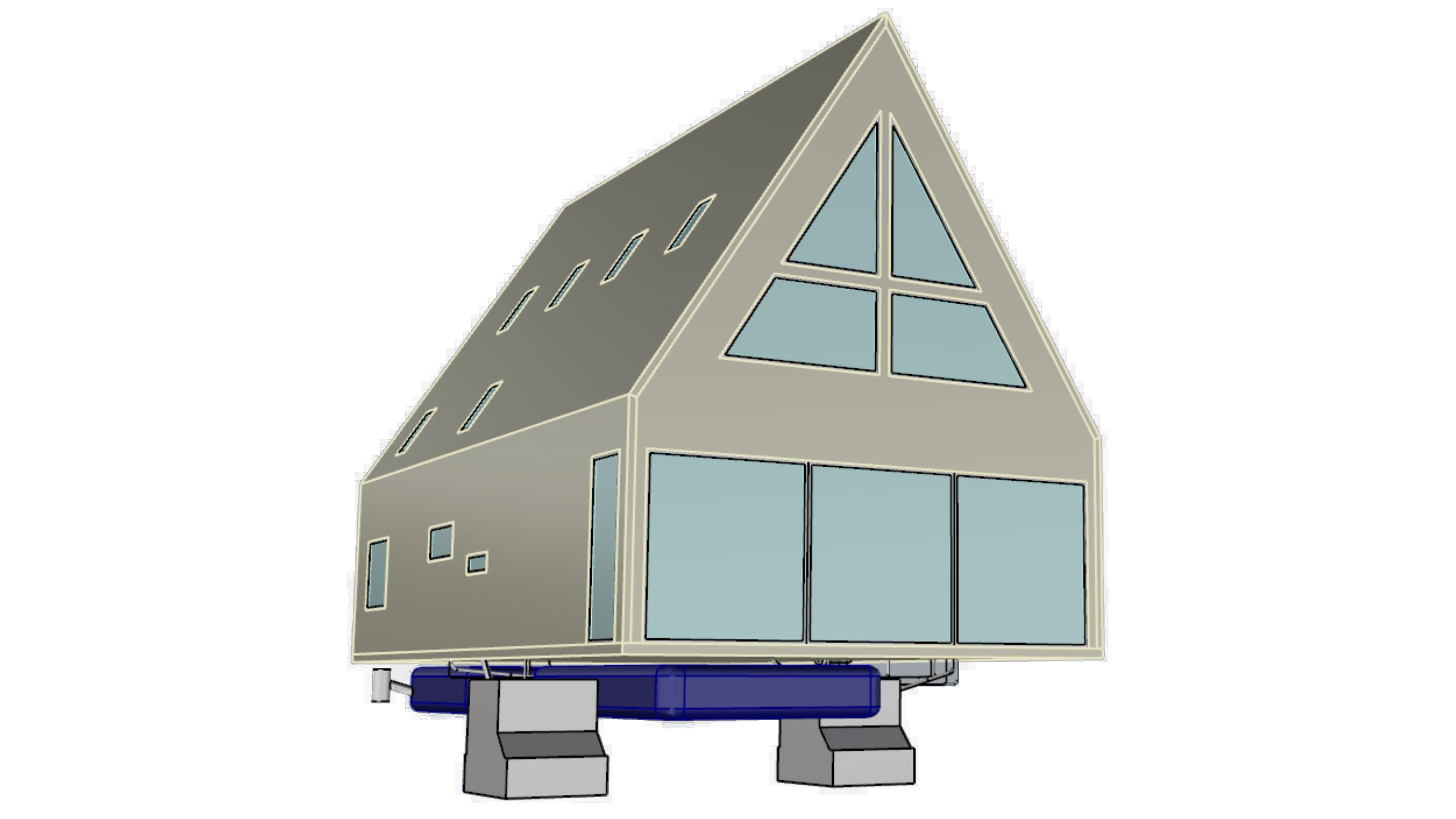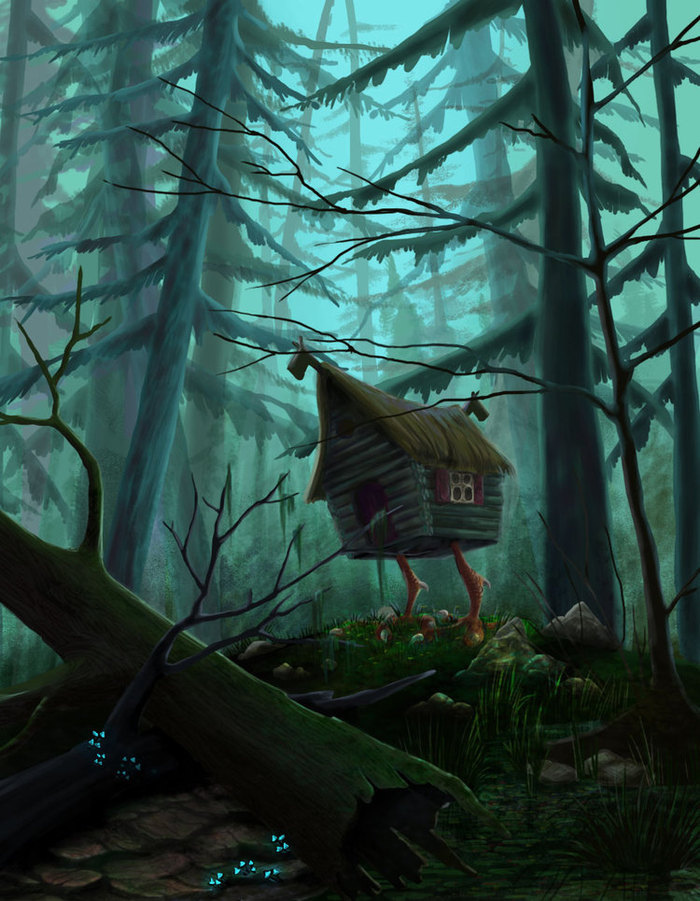The Seed is Baba Yaga’s Hut…
Dear Readers,
As much as I believe Baba Yaga is a complex, terrifying, and intrinsically beautiful character in Russian fairy tales…I don’t necessarily want our home to look like her hut. And the two Clivus Multrum composting tanks do exactly that…they make The Seed look like it has two chicken feet.

Current modeled image of The Seed, with the clivus multrum tanks looking like the chicken feet of baba yaga’s hut…
Computer Graphic, “Избушка Бабы-Яги” (“Baba Yaga’s Hut”) by artist Strekoza. https://illustrators.ru/illustrations/524931
The Conundrum
The U.S. designs of the Clivus Multrum are tall. In the design above, we have two M2 models of the Clivus Multrum. They are each designed for an average of 15 daily uses, and to accommodate three people. They each are between 6.5 and 7 feet high, and that height does not include the required 12’’ of extra space above the tank for ventilation equipment.1 These compost holding tanks will also be enclosed in the home’s envelope, and therefore would require additional height allowances.
The height becomes a problem due to the fact that William and I want to avoid digging. For prefabrication purposes, it is easier if we do not have to dig in order to install the tanks. For our own personal purposes, we simply want to avoid disrupting the natural soils on our land as much as possible.
Two Possible Solutions…with large ‘BUT’s.
One, we could go Aussie. The Australian versions of the Clivus Multrum are significantly lower in height. A CM10 model is designed for an average of 25 daily uses, and is only 3.6 feet high. BUT, while the Australian version is certified to Australian and New Zealand wastewater treatment standards by SAI Global…they are not NSF certified. From my little research into PA DEP code, only NSF certified wastewater treatment products will be considered as acceptable.2 U.S. Clivus Multrums, on the other hand, are indeed certified to NSF standards.
Two, we could re-design our home to utilize only one U.S. Clivus Multrum. One M10 model is designed for an average of 60 daily uses and to accommodate 6 people…and is only between 6 and 6.5 feet in height. Only using one tank makes maintenance easier because there is only one composting process taking place. Using two tanks only works efficiently under the assumption that each toilet is being used equally, and the compost is being generated at the same rate. This will most likely not be the case. One toilet may be used more than the other, and therefore they would each need emptied at different times.
Using one tank that can handle 60 uses a day, in comparison to using two tanks that can only handle 30 in total a day, also just makes sense…for us…meaning ‘me’… anyways. I use the bathroom exponentially more than William does. I probably use it 15 times in a day just on my own. A tank that can handle more usages, would also be able to handle me, as well as the multiple children and frequent guests we will most likely have over at our house.
One tank also makes the digging conundrum less of a conundrum. We would only have to dig enough for one composting tank, which, in itself, is smaller than the M2 models. The M10 model is only between 6 and 6.5 feet in height, in comparison to the M2 models which were each 6.5 to 7 feet in height.
BUT, the problem with using only one composting tank, is that no less than a 45 degree slope can be between each toilet and the tank.3 With our current floor plan, there is no way we can get the two foam flush toilets close enough to share the same composting tank…
Any thoughts or suggestions would be most welcome! Otherwise, perhaps I will make a chicken leg mosaic to decorate the envelope of our composting tanks…If we are to live in Baba Yaga’s hut, we might as well embrace it!
Thanks for reading!!
Shelby
1. Clivus Multrum Inc. “Clivus Multrum Residential Planning Manual”, August 2009. Page 6.
2. Commonwealth of Pennsylvania. “Title 25- Environmental Protection. Chapter 73- Standards for Onlot Sewage Treatment Facilities, Standards for Aerobic Treatment Tanks, 73.32.” 31 Oct. 2020. www.pacodeandbulletin.gov/Display/pacode?file=/secure/pacode/data/025/chapter73/s73.32.html&d=reduce. Accessed on 16 March 2021.
3. Clivus Multrum Inc. “Clivus Multrum Residential Planning Manual,” August 2009. Page 10.
2 Comments
Submit a Comment
© 2020 Sustaining Tree
© 2020 Sustaining Tree


Need your footnotes in order to reply intelligently.
As a stupid reply.
1) if you are a writer (and you are) embrace your right to create words, e.g., less “conundrical” in lieu of “less of a conundrum.” It is great fun.
2) Be careful where you place references to illustrations (hint: “design above” should not come beneath that marvelous computer graphic).
Hello, Mr. Wheatley! Thank you for the suggestions! 🙂 You are correct, I should’ve placed my reference to our home’s illustration more appropriately. I also completely agree that making up words can be great fun! I shall e-mail you the clivus multrum residential planning manual for your perusal! Thanks again for reading!